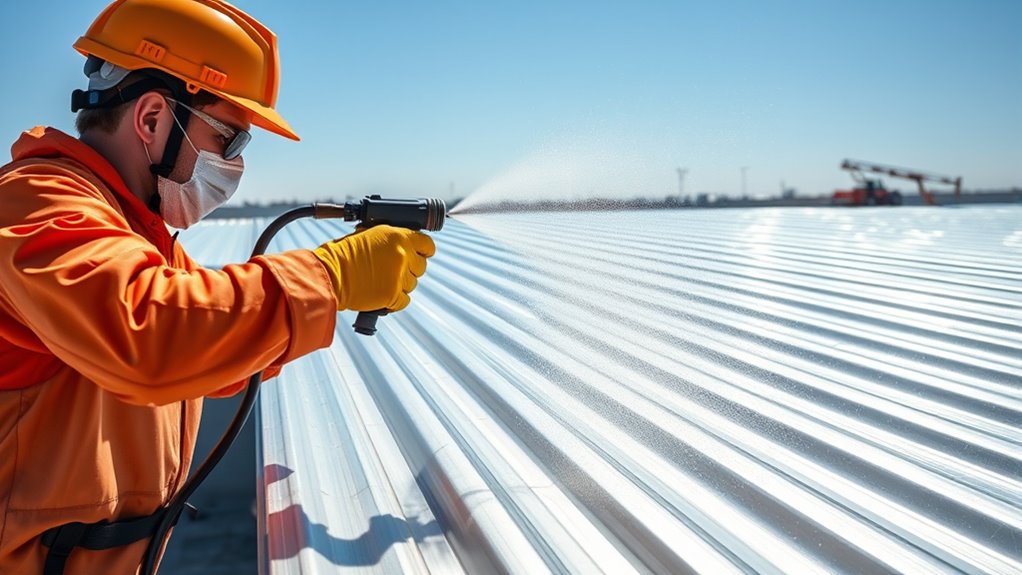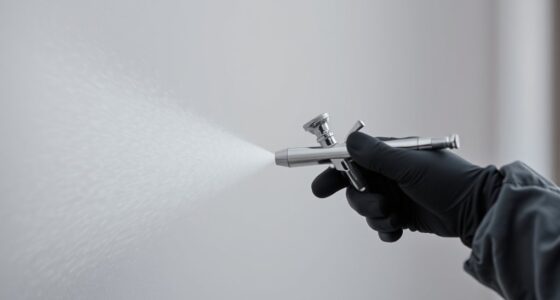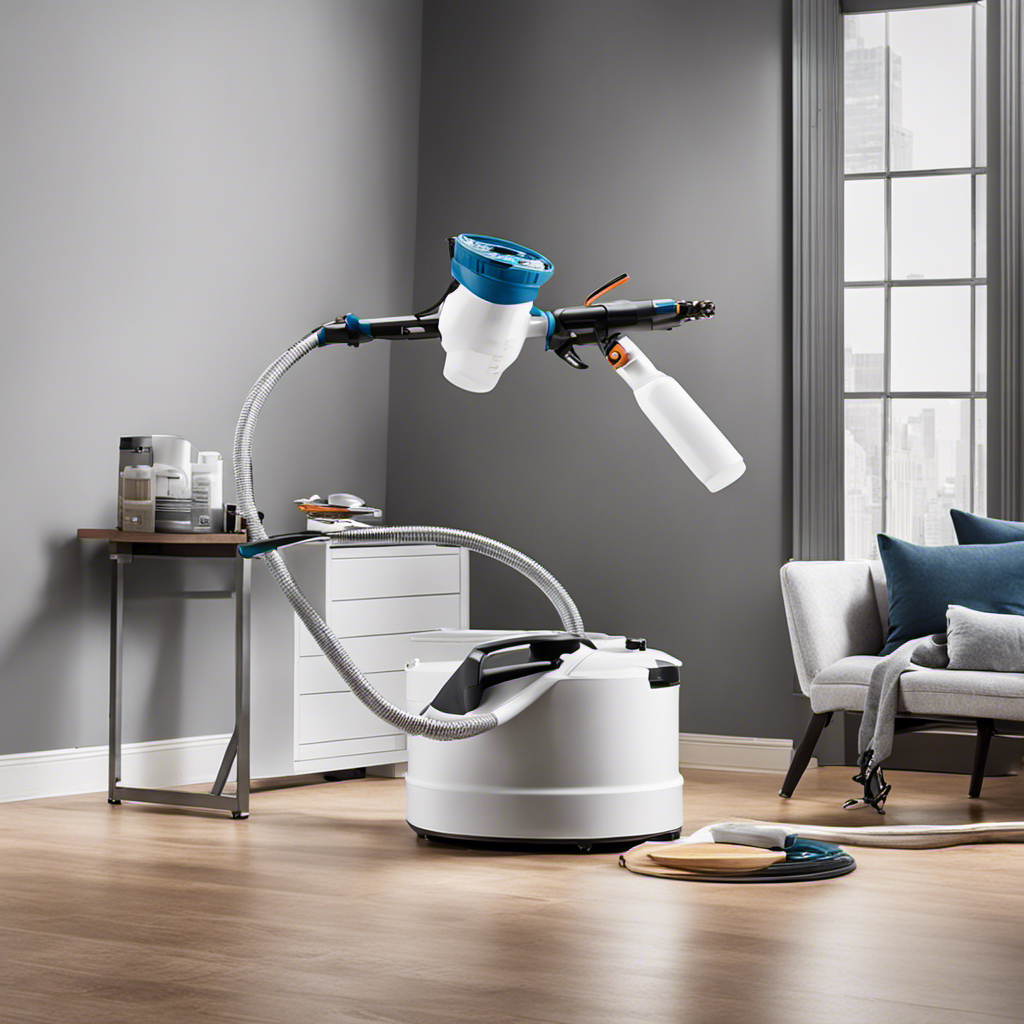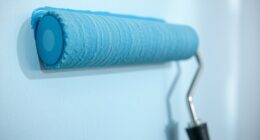To spray metal roofing and corrugated panels, start by cleaning the surface thoroughly to remove dirt, grease, or rust, then lightly sand for better adhesion. Use a high-quality HVLP sprayer, holding it 6-12 inches from the surface with smooth, overlapping strokes. Apply multiple thin coats, allowing each to dry properly. Keep weather conditions moderate and follow manufacturer instructions closely. For detailed tips on achieving a professional finish, continue exploring the essential techniques involved.
Key Takeaways
- Thoroughly clean and lightly sand the panels to ensure proper adhesion before painting.
- Use a high-quality HVLP sprayer, keeping it 6-12 inches from the surface with smooth, overlapping strokes.
- Apply multiple thin coats, allowing adequate drying time between each to prevent drips and ensure durability.
- Paint on days with moderate temperature and low humidity for optimal drying and adhesion.
- Follow manufacturer instructions carefully and mask adjoining areas to prevent overspray for a professional finish.

Have you ever considered spraying metal roofing instead of traditional methods? It’s an efficient way to achieve a smooth, even finish while reducing the mess and labor involved in brush or roller applications. When it comes to spraying, understanding the importance of paint durability is key to guaranteeing your roof withstands weather, UV rays, and the test of time. The right application techniques can dramatically improve the longevity and appearance of your metal roofing, giving it a fresh, professional look that lasts.
First, prepare your surface thoroughly. Clean the metal panels to remove dirt, grease, and loose rust, and then lightly sand the surface to promote adhesion. A clean, smooth surface ensures that the spray coating bonds well, which is essential for maximizing paint durability. Once the surface is prepped, mask off adjoining areas to prevent overspray from landing where it’s not wanted. Proper masking saves time and effort during cleanup, allowing you to focus on applying the coating evenly.
Thoroughly clean and lightly sand metal surfaces before masking to ensure optimal paint adhesion and durability.
When it comes to application techniques, using the right equipment makes all the difference. A high-quality HVLP (High Volume Low Pressure) sprayer is ideal for spraying metal roofing because it provides a fine, even spray pattern that reduces overspray and material waste. Keep the spray gun at a consistent distance—usually about 6 to 12 inches from the surface—and use smooth, overlapping strokes to ensure uniform coverage. Maintain a steady pace and avoid stopping in the middle of a section, as this can cause uneven textures or drips.
Temperature and humidity also play essential roles in achieving best results. Aim to spray on a day with moderate temperatures and low humidity, as extreme weather can affect how the paint dries and adheres. Follow the manufacturer’s recommended drying times between coats to prevent peeling or cracking later on. Multiple thin coats generally produce better durability than a single thick layer, sealing the panels effectively and providing enhanced protection against corrosion and UV damage. Additionally, understanding the benefits of modern toilet technology can help you make more resource-efficient choices in your home or business.
Finally, always follow the manufacturer’s instructions for the specific paint you’re using. Proper application techniques combined with high-quality products will maximize paint durability, ensuring your sprayed metal roof remains resilient and attractive for years. With patience and attention to detail, spraying your metal roofing can be a quick, cost-effective alternative to traditional painting methods, delivering a sleek, durable finish that stands up to the elements.
Frequently Asked Questions
What Type of Spray Paint Is Best for Metal Roofing?
For metal roofing, you should choose high-quality, acrylic latex or elastomeric spray paint designed for metal surfaces. These paints offer excellent paint adhesion and flexibility, preventing cracking over time. Before spraying, make certain proper surface preparation by cleaning and removing rust or dirt. This step enhances paint adhesion, ensuring a durable finish that withstands weather conditions. Always follow the manufacturer’s instructions for best results and longevity.
How Do I Prevent Overspray on Surrounding Areas?
To prevent overspray on surrounding areas, you need to stay vigilant. Start by covering nearby surfaces with drop cloths, and use masking tape to seal edges thoroughly. Keep your spray gun steady and maintain a consistent distance. Pay close attention to wind conditions, and work in calm weather. With these precautions, you’ll minimize mess and guarantee your project looks clean and professional—no surprises, just perfect results.
Can I Spray Metal Roofing in Wet or Humid Conditions?
You should avoid spraying metal roofing in wet or humid conditions because weather considerations greatly impact the quality of your finish. Humidity can cause paint to misapply or not adhere properly, and moisture can lead to rust. Guarantee surface preparation is thorough, dry, and free of moisture before spraying. Wait for a clear, dry day with low humidity for best results, and prioritize proper surface prep to achieve a durable, professional finish.
How Long Should I Wait Between Coats?
You should wait at least 2 to 4 hours between coats, depending on the paint’s drying time and your application’s timing. Check the manufacturer’s instructions for specific drying times, as environmental conditions like humidity and temperature can affect this. Make sure the first coat is fully dry before applying the next to ensure proper adhesion and a smooth finish. Rushing the process can lead to uneven coverage and peeling later on.
Is Special Equipment Required for Spraying Corrugated Panels?
No need for a spaceship to spray corrugated panels, but you’ll want the right gear. Equipment requirements include a suitable spray gun, ideally with adjustable spray nozzle types to handle curves and ridges. You might think a garden hose will do, but investing in a professional-grade sprayer guarantees even coverage and smooth finishes. So, skip the DIY disaster, grab the proper equipment, and spray away with confidence!
Conclusion
So, now you’re a spray metal roofing pro—who knew it was so easy to turn your roof into a shiny, waterproof masterpiece? Just remember, a little spray can go a long way, and don’t forget to wear your funky goggles and gloves—you don’t want to look like a paint-splattered superhero. With this new skill, your roof will stay dry, stylish, and maybe even jealous of your DIY prowess. Happy spraying—your roof’s about to thank you!
Franz came aboard the Paint Sprayer Zone team with a background in both journalism and home renovation. His articulate writing style, combined with a passion for DIY projects, makes him an invaluable asset. Franz has a knack for breaking down technical jargon into easy-to-understand content, ensuring that even the most novice of readers can grasp the complexities of paint sprayers.










